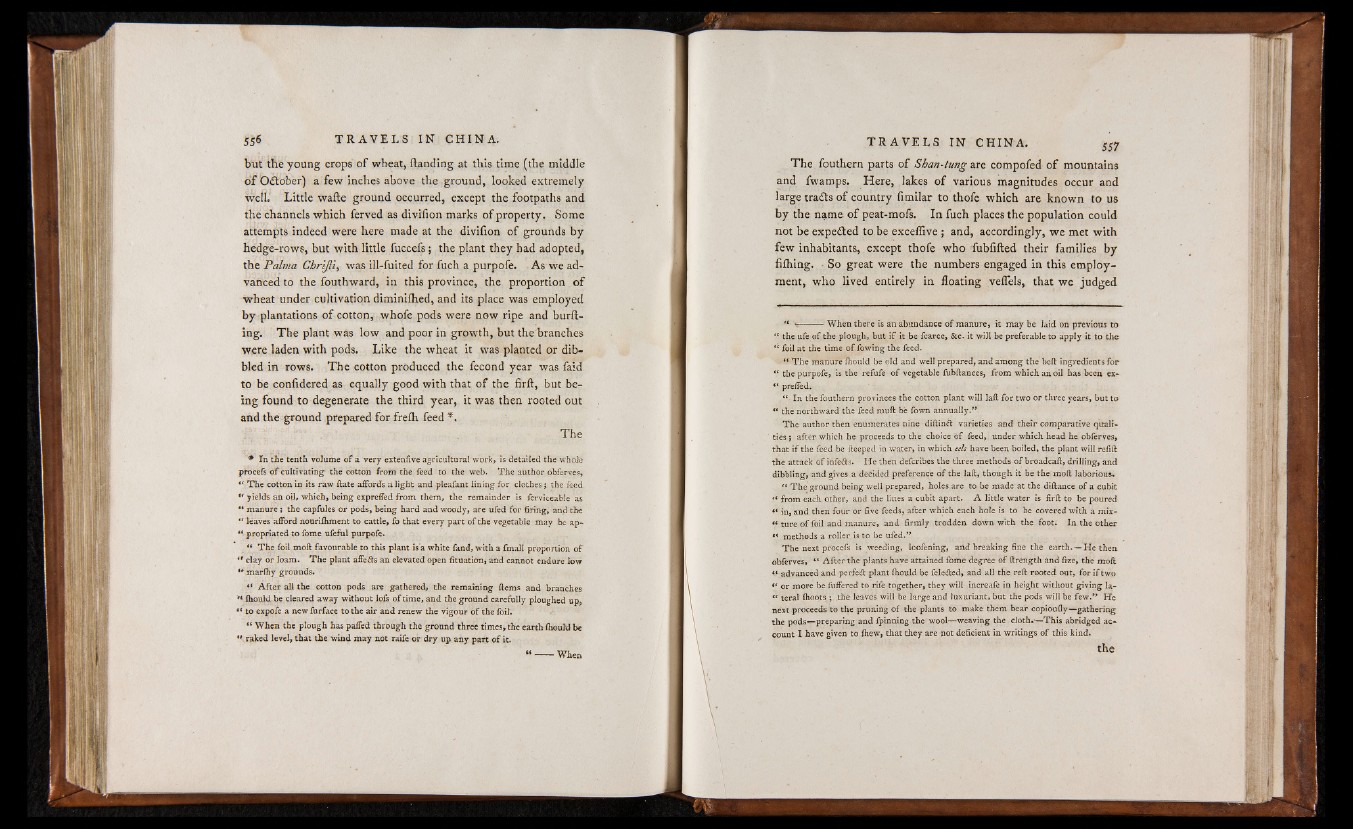
but the young crops o f wheat, Handing at this time (the middle
o f Odlober) a few inches above the ground, looked extremely
well. Little wafte ground occurred, except the footpaths and
the channels which ferved as divifion marks o f property. Some
attempts indeed were here made at the divifion o f grounds by
hedge-rows, but with little fuccefs ; the plant they bad adopted,
the Palma Cbrijli, was ill-fuited for fuch a purpofe. As we advanced
to the fouthward, in this province, the proportion o f
wheat under cultivation diminiihed, and its place was employed
by plantations o f cotton, whofe pods were now ripe and burft-
ing. The plant was low and poor in growth, but the'branches
were laden with pods. Like the wheat it was planted or dibbled
in rows. The cotton produced the fecond year was faid
to be confidered as equally good with that o f the firft, but being
found to degenerate the third year, it was then rooted out
and the ground prepared for freih feed * .
The
* In the tenth volume o f a v ery extenfive agricultural work, is detailed the whofe
proceis o f cultivating the cotton from the feed to the web. T h e author obferves,
“ T h e cotton in its raw ftate affords a ligh t and pleafant lining for clothes j the feed.
u yields an oil, which, being exprefled from them, the remainder is ferviceable as
** m anu re; the capfules or pods, being hard and woody, are ufed for firing, and the
“ leaves afford nouriihment to cattle, fo that every part o f the vegetable may be ap~
44 propriated to fome ufeful purpofe.
44 T h e foil moft favourable to this plant is’a white fand, with a fmall proportion o f
ft clay or loam. T h e plant affeils an elevated open fituation, and cannot endure low
** marfliy grounds.
4‘ A f te r all the cotton pods are gathered, the remaining ftems and branches
H ihould, be cleared away without lofs o f time, and the ground carefully ploughed up,
44 to expofe a new furface to the air and renew the vigour o f the foil.
44 W hen the plough has pafled through the ground three times, the earth ihould be
“ raked level, that the wind m ay not raife or d ry up any part o f it.
1 when
The fouthern parts o f Sban-tung are compofed o f mountains
and fwamps. Here, lakes o f various magnitudes occur and
large tra£ts o f country fimilar to thofe which are known to us
by the name o f peat-mofs. In fuch places the population could
not be expeiled to be exceffive; and, accordingly, we met with
few inhabitants, except thofe who fubfifted their families by
fifhing. • So great were the numbers engaged in this employment,
who lived entirely in floating vefiels, that we judged
“ When there is an abundance o f manure, it may be laid on previous to
if the ufe o f the plough, but i f it be fcarce, & c. it will be preferable to apply it to the
44 foil at the time of.fowing the feed.
44 T h e manure ihould be old and well prepared, and among the beft ingredients fo r
“ the purpofe, is the refufe o f vegetable fubilances, from which an oil has been ex-
44 prefled.
“ In the fouthern provinces the cotton plant will Iait for two or three years, but to
M thè northward the feed mull bè fown annually.”
T h e author then enumerates nine diftinft varieties and their comparative qualities
; after which he proceeds to the choice o f feed, under which head he obferves,
that i f the feed be fteeped in water, in which eels have been boiled, the plant will refill
the attack o f infe&s. He then defcribes the three methods o f broadcall, drilling, and
dibbling, and gives a decided preference o f the laft, though it be the moll laborious.
“ T h e ground being well prepared, holes are to be made at the dillance o f a cubit
“ from each other, and the lines a cubit apart. A little water is firft to be poured
44 in, and then four or five feeds, after which each hole is to be covered with a mix-
É ture o f foil and manure, and firmly trodden down with the foot; In the other
44 methods a roller is to be ufed.”
T h e next procefs is weeding, loofening, and breaking fine the earth. — H e then
obferves, * A fte r the plants have attained fome degree o f ftrength and fize, the moft
advanced and perfeil plant ihould be feleiled, and all the reft rooted out, for i f two
or more be fuffered to rife together, they will increafe in height without giving la -
u teral ihoots* the leaves will be large and luxuriant, but the pods will be few.” He
next proceeds to the pruning o f the plants to make them bear copiouily— gathering
the pods— preparing and fpinning the wool— weaving the cloth.’— Th is abridged account
I have given to ihew, that they are not deficient in writings o f this kind.
the